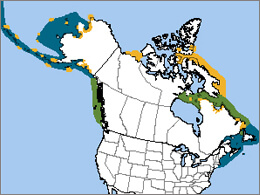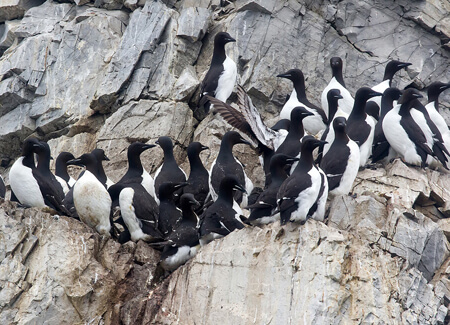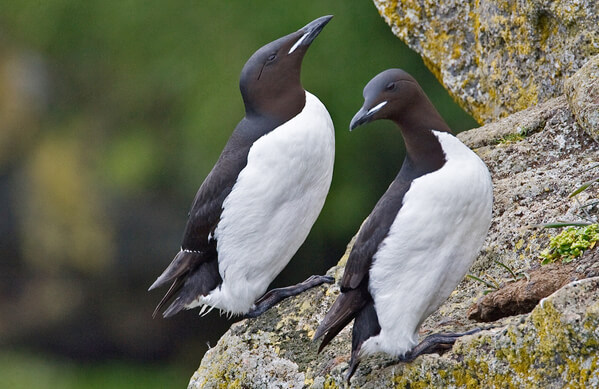 The sturdy, black-and-white Thick-billed Murre is one of the largest living members of the Alcidae, a family of seabirds that also includes the Tufted Puffin and Marbled Murrelet. This family once included the Great Auk, which was driven to extinction by overhunting in the mid-19th century.
The sturdy, black-and-white Thick-billed Murre is one of the largest living members of the Alcidae, a family of seabirds that also includes the Tufted Puffin and Marbled Murrelet. This family once included the Great Auk, which was driven to extinction by overhunting in the mid-19th century.
Although native peoples harvest Thick-billed Murre eggs and adults for food in some Arctic areas, bigger threats to its survival are entanglement in fishing nets and the effects of climate change.
This rugged seabird is told from its look-alike relative, the Common Murre, by a thin white stripe along its bill. Four subspecies of Thick-billed Murre are recognized, with only two occurring in North America–one in the Pacific and one in the Atlantic.
The species' breeding range is circumpolar; it includes arctic and subarctic regions in the Atlantic, Arctic, and Pacific Oceans. In North America, the birds nest in Atlantic and arctic Canada and Alaska. A few pairs also nest in British Columbia.
Underwater Flier
This ocean-going bird mostly eats fish, including cod and herring, along with shrimp, squid, marine worms, and other crustaceans. Like other seabirds, such as Hawaiian Petrel and Newell's Shearwater, adults forage at sea, often many miles away from colony. Both parents feed the chick, almost entirely on fish.
Like other auks, Thick-billed Murres forage while swimming underwater. They may dive to more than 300 feet in pursuit of their prey, using their stubby wings to "fly" through the water much as Galápagos Penguins and other penguins do. Their actual flight is strong and direct, with fast wing beats due to their short wings.
Sign up for ABC's eNews to learn how you can help protect birds

Thick-billed Murre colony. Photo by Maskimilian, Shutterstock
Tough Chicks
The Thick-billed Murre does not build a nest. Instead, the birds lay their single eggs on a narrow ledge on a steep cliff face. Their huge breeding colonies can number up to a million birds and often mix with Common Murres.
The eggs of this murre are uniquely shaped: round at one end and pointed at the other. This “pyriform” shape lets the egg roll around in a circle if bumped, instead of falling off the cliff.
Only three weeks after hatching, the still-flightless chick jumps from its high ledge and glides down to the sea, accompanied by the adult male, who will feed and care for it for several weeks afterward. The birds begin an incredible migration southward, swimming up to 600 miles. Once their flight feathers develop, the birds fly farther south to their wintering grounds.
Standing Up for Seabirds
ABC's Seabird Program continues work to protect all seabirds. For example, we support legislation to implement the Agreement on the Conservation of Albatrosses and Petrels in the United States.
In addition, our interactive fisheryandseabird.info tool helps fisheries avoid “bycatch,” or accidental catch—one of the major threats to ocean-going birds.
Donate to support ABC's conservation mission!



















































